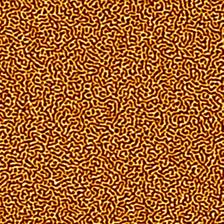The picture of a 10µm by 10µm sample made with a magnetic force microscope shows the labyrinth-like structure of the magnetic domains. (Image: Bastian Pfau)
Scientists from TU Berlin, DESY and the University of Paris discovered a surprising effect in the demagnetisation of ferromagnetic materials at DESY’s free-electron laser FLASH. The team of researchers headed by Professor Stefan Eisebitt from Technische Universität Berlin is part of an international collaboration, they published the results in “Nature Communications” (DOI 10.1038/ncomms2108). The scientists found that electrons can move very quickly between areas with different magnetisation and thereby influence the demagnetisation of the material. The effect could play a decisive role in reducing the size of magnetic memories. “Optical demagnetisation is by far the quickest process to change magnetisation locally, and this in turn is the basis of magnetic storage,” Eisebitt explains. “Therefore, optical processes could help make magnetic memories faster in the future.”
The scientists discovered this effect while studying a phenomenon that has been a hot research topic for 20 years, ever since it was known that ferromagnets, for example magnetised iron, can be demagnetised extremely quickly when they are radiated with laser light pulses. In a few hundred femtoseconds (one femtosecond, 10-15 s, is a billionth of a millionth of a second) magnetisation breaks down and the ferromagnet loses its magnetic properties. After a while, magnetisation builds up again. When investigating this process at the X-ray laser FLASH, the scientists detected another mechanism that causes demagnetisation. It occurs when the material is divided into magnetic domains, which is often the case. “When bombarded with laser light, released electrons that speed through the material will break through the domain walls, thereby virtually changing sides. This way, they go from one domain into another domain with a different magnetic polarisation, causing the destruction of the local magnetisation,” explains junior scientist and lead author Bastian Pfau from TU Berlin. “Materials with nanometre-sized domains can this way develop another possibility of demagnetisation as soon as electrons become more mobile through the laser bombardment.” Such an interaction between two magnetic domains had already been assumed in theory, but has never before been observed.
The prerequisite of this kind of demagnetisation is that the basic material is divided into domains, which is usually the case with ferromagnets. Therefore, an unmagnetised iron bar consists of many microscopically small areas. Within these areas, the magnetisation has the same direction, but there is a random magnetisation of these miniature areas towards each other. When the iron bar is magnetised, for example when a magnetic field is applied from outside, the magnetic fields of the individual domains align in parallel and the whole iron bar becomes magnetic.
These experiments were carried out at DESY’s free-electron laser FLASH in Hamburg. They investigated samples of a cobalt-platinum layer system containing tiny labyrinth-like magnetic domains. First, the working group induced the demagnetisation of the sample with an extremely short infrared laser pulse. After a “wait” of some hundred femtoseconds, the actual magnetisation of the sample was analysed with the help of FLASH X-ray laser light.
The investigation of the scientists’ team showed that the initially sharp walls between the different domains became “blurred”, i.e. fuzzy, shortly after the infrared laser pulse – the limits became wider because the electrons broke through the domain walls. This became visible when, shortly after pumping, the probe X-ray pulses of the FLASH accelerator hitting the sample met a weaker deflection of their flight direction than before. Extensive simulations of the electron movement verified that this observation can be explained with a theoretically predicted demagnetisation mechanism through a change of domain by electrons.
(Info from DESY Press release)
| Further Links |
|







